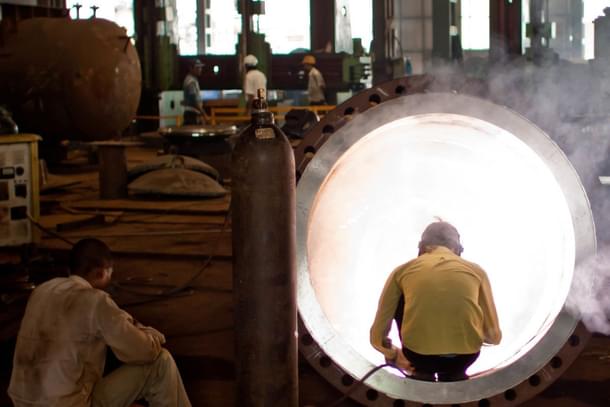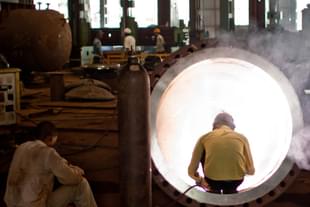Economy
The Good, The Bad And The Ugly Of Q1 GDP: Only Two Growth Engines Are Firing
R Jagannathan
Aug 31, 2021, 07:31 PM | Updated 07:31 PM IST
Save & read from anywhere!
Bookmark stories for easy access on any device or the Swarajya app.


The first thing to note about the first quarter gross domestic product (GDP) numbers for the current fiscal (April-June 2021-22) is that we should ignore the growth rates, and focus on the absolutes and sectoral performance.
When GDP contracted by 24.4 per cent and gross value added (GVA) by 22.4 per cent in the first quarter of last year, one can hardly be exulted by the 20.1 per cent and 18.8 per cent rise this year. We are still not where we were two years ago. (GDP is GVA plus taxes minus subsidies).
So, what do the absolute figures tell us? What’s the good news, and the bad?
First, the fact that the first quarter this year — when the Covid second wave hit us even more badly than the first — shows positive growth over last year’s numbers means that this time the lockdowns did not do as much damage as last year. We have learnt from last year’s heavy restrictions, and even uncoordinated lockdowns at the state level have worked much better this time.
Second, last year, all sectors barring agriculture bore the brunt of the lockdowns; this year, all sectors show positive growth over that low base. So, while the positive year-on-year growth is notable given the intensity of this year’s second wave in Q1, the percentage increases make little sense.
Construction grew 68.3 per cent, manufacturing by 49.6 per cent, trade, hotels, transport and communications grew 34.3 per cent and mining by 18.6 per cent. These represent no real growth, but merely a sense of bounce from last year’s large lows.
Third, even with GDP growth of 20.1 per cent and GVA of 18.8 per cent, we are still below the actual numbers achieved in 2019-20, ie, before the pandemic. In constant currency terms, first quarter GDP and GVA numbers are significantly lower than in 2019-20.
The absolute figures for GDP and GVA this year and in the first quarter of 2019-20 are Rs 32.38 lakh crore and Rs 30.47 lakh crore, much lower than the figures for two years ago at Rs 35.66 lakh crore and Rs 33.05 lakh crore. That’s what we have to make up in the remaining three quarters of this fiscal.
Fourth, and here is the cause for some hope. In money terms, both GVA and GDP are higher than in 2019-20, reflecting the fact that inflation is now boosting the absolute value of these two numbers. In current terms, GVA has risen from Rs 45.77 lakh crore in Q1 2019-20 to Rs 46.19 lakh crore this year, and GDP from Rs 50.04 lakh crore in 2019-20 Q1 to Rs 51.22 lakh crore.
This is not important if you are looking for the real value of the rupee in domestic terms, but matters when we are talking about GDP in dollars. Between August end 2019 and now, the rupee has held more or less steady in the Rs 72-73 range, which means our GDP is at least back to where it was two years ago in dollar terms. The goal of a $5 trillion economy has slipped by two years. We should get there by 2026-27, not 2024-25, if the rupee does not depreciate like it did in the past.
Fifth, agriculture is the one sector that did well despite Covid, with GVA growing 4.5 per cent in Q1 this year, which is over and above last year’s 3.5 per cent. This should tell us one thing: our agitating Punjab and Haryana farmers are asking too much from their country.
The rest of the economy has suffered, but the one sector that actually benefited from the Covid-induced slowdown is demanding more from sectors that are down. This is like asking a sick man to give blood transfusions to healthier individuals. Our farmers should know when to stop demanding the moon.
Sixth, manufacturing, mining, electricity, finance and real estate are closest to revival to the levels of 2019-20. The sector with the greatest distance to cover to reach even 2019-20 levels is trade, hotels, transport and communications, where GVA levels are still at only 70 per cent of what they were two years ago. This is where jobs are doing badly, and growth needs a real stimulus.
Seventh, private final consumption expenditure (PFCE), the primary driver of growth in the past, is weak. It is holding steady at over 55 per cent of GDP, but when GDP itself has shrunk, it implies that people are consuming far less than before Covid.
PFCE in Q1 2021-22 is just 88 per cent of levels two years ago, at Rs 17.83 lakh crore against Rs 20.24 lakh crore in 2019-20. That’s a Rs 2.41 lakh crore cut in real consumption expenditures over two years. That is what is preventing the Indian economy from a sharper revival. Government's final consumption expenditure is up, at Rs 4.21 lakh crore against Rs 3.92 lakh crore two years ago.
Eighth, investment, as represented by gross fixed capital investment, is also down from two years ago, at Rs 10.22 lakh crore versus Rs 12.33 lakh crore.
Ninth, exports are doing fine — finally. Exports are up from Rs 7.06 lakh crore two years ago to Rs 7.68 lakh crore.
Net-net: of the four growth engines, private consumption, government consumption, exports and investment, only two are firing: government spends and exports. The stimulus must focus on reviving animal spirits in the other two groups, consumers and corporates.
Jagannathan is former Editorial Director, Swarajya. He tweets at @TheJaggi.





